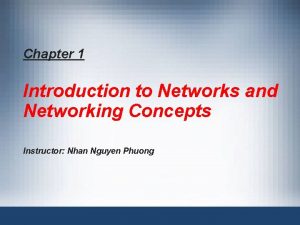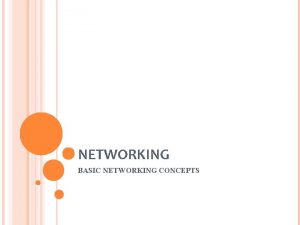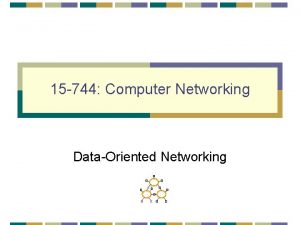Computer Networking Concepts Source Routing Source Routing IEEE







- Slides: 7

Computer Networking Concepts: Source Routing

Source Routing • • IEEE 802. 5 does NOT provide Source Routing as part of the IEEE standard. Only IBM Token Ring uses Source Routing. In Source Routing, the Source is responsible for determining the best path to the Destination. The Source sends out a XID (Exchange ID) or TEST frame which picks up routing information along the way to the Destination. As the XID frame goes through bridges/routers, the bridges/routers add their route information into the MAC Info field's Routing Information. The route information contains the Bridge # and the Segment #. Because multiple routes may exist between rings, the Bridges check the route information to see if the XID frame has already passed into the ring. If it has, the frame is ignored. If it has not been into the new ring, the frame is passed on.

Source Routing con’t If Station X on Ring 100 wanted to send information to Station Y on Ring 500. Station X would first send out a local ring MAC Token Frame.

Source Routing con’t • When the Frame returns with A/C = 00 then Station X would send a XID Frame (sometimes called a Discovery Frame) to see if Station Y was on another ring. • The XID Frame would go to Bridges A, B & C and each would forward the XID Frame to Rings 200, 300 and 400 respectively. • There would be 3 new XID Frames generated now on Segments 200, 300 & 400. • Each XID Frame would have the Bridge # and Segment # added to the Routing Information field.

Source Routing con’t • Because Station Y is not on Segments 200, 300 or 400, Bridges D, E & F forward the XID frame to Segment 500. • There are now 3 XID Frames forwarded to Segment 500 - Note: only 1 XID Frame exists on the ring at any 1 time. • Station Y acknowledges each of the XID Frames in turn, changes the direction bit in the Routing Information field and they are returned to the Source in the same order. • Station X receives the first XID frame and uses its routing information for all subsequent frame transmission to Station Y. Station X ignores all other XID frames. • The assumption is made that the first XID frame received back is the quickest and best route. • This method of Source Routing is called All Routes Broadcast (ARB). • If a Spanning Tree Algorithm is used then only 1 path would exist between Station X and Station Y. • When Source Routing is used with a Spanning Tree Algorithm, it is called a Single Route Broadcast (SRB).

Note: In IEEE 802. 5 and IBM Token Ring, it is the responsibility of the MAC layer to find the best route. Ethernet relies on the Network layer to find the best route.

References Introduction to Data Communications Copyleft Sept. 1999 - Jan 2005 TCP/IP Tutorial and Technical Overview An IBM Redbooks publication Published 19 December 2006 Computer Networking: A Top-Down Approach (7 th Edition) James Kurose & Keith Ross













